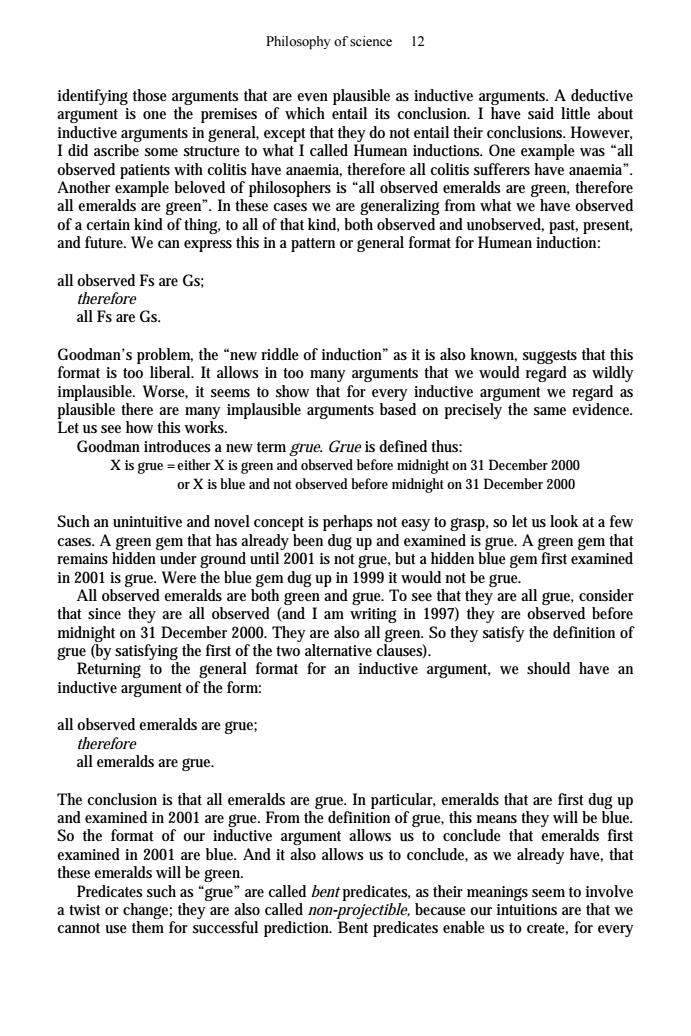正在加载图片...

Philosophy of science 12 identifying those arguments that are even plausible as inductive arguments.A deductive argument is one the premises of which entail its conclusion.I have said little about inductive arguments in general,except that they do not entail their conclusions.However, I did ascribe some structure to what I called Humean inductions.One example was "all observed patients with colitis have anaemia,therefore all colitis sufferers have anaemia". Another example beloved of philosophers is "all observed emeralds are green,therefore all emeralds are green".In these cases we are generalizing from what we have observed of a certain kind of thing,to all of that kind,both observed and unobserved,past,present, and future.We can express this in a pattern or general format for Humean induction: all observed Fs are Gs; therefore all Fs are Gs. Goodman's problem,the "new riddle of induction"as it is also known,suggests that this format is too liberal.It allows in too many arguments that we would regard as wildly implausible.Worse,it seems to show that for every inductive argument we regard as plausible there are many implausible arguments based on precisely the same evidence. Let us see how this works. Goodman introduces a new term grue.Grue is defined thus: X is grue =either X is green and observed before midnight on 31 December 2000 or X is blue and not observed before midnight on 31 December 2000 Such an unintuitive and novel concept is perhaps not easy to grasp,so let us look at a few cases.A green gem that has already been dug up and examined is grue.A green gem that remains hidden under ground until 2001 is not grue,but a hidden blue gem first examined in 2001 is grue.Were the blue gem dug up in 1999 it would not be grue. All observed emeralds are both green and grue.To see that they are all grue,consider that since they are all observed (and I am writing in 1997)they are observed before midnight on 31 December 2000.They are also all green.So they satisfy the definition of grue (by satisfying the first of the two alternative clauses). Returning to the general format for an inductive argument,we should have an inductive argument of the form: all observed emeralds are grue; therefore all emeralds are grue. The conclusion is that all emeralds are grue.In particular,emeralds that are first dug up and examined in 2001 are grue.From the definition of grue,this means they will be blue. So the format of our inductive argument allows us to conclude that emeralds first examined in 2001 are blue.And it also allows us to conclude,as we already have,that these emeralds will be green. Predicates such as "grue"are called bent predicates,as their meanings seem to involve a twist or change;they are also called non-projectible,because our intuitions are that we cannot use them for successful prediction.Bent predicates enable us to create,for everyidentifying those arguments that are even plausible as inductive arguments. A deductive argument is one the premises of which entail its conclusion. I have said little about inductive arguments in general, except that they do not entail their conclusions. However, I did ascribe some structure to what I called Humean inductions. One example was “all observed patients with colitis have anaemia, therefore all colitis sufferers have anaemia”. Another example beloved of philosophers is “all observed emeralds are green, therefore all emeralds are green”. In these cases we are generalizing from what we have observed of a certain kind of thing, to all of that kind, both observed and unobserved, past, present, and future. We can express this in a pattern or general format for Humean induction: all observed Fs are Gs; therefore all Fs are Gs. Goodman’s problem, the “new riddle of induction” as it is also known, suggests that this format is too liberal. It allows in too many arguments that we would regard as wildly implausible. Worse, it seems to show that for every inductive argument we regard as plausible there are many implausible arguments based on precisely the same evidence. Let us see how this works. Goodman introduces a new term grue. Grue is defined thus: X is grue = either X is green and observed before midnight on 31 December 2000 or X is blue and not observed before midnight on 31 December 2000 Such an unintuitive and novel concept is perhaps not easy to grasp, so let us look at a few cases. A green gem that has already been dug up and examined is grue. A green gem that remains hidden under ground until 2001 is not grue, but a hidden blue gem first examined in 2001 is grue. Were the blue gem dug up in 1999 it would not be grue. All observed emeralds are both green and grue. To see that they are all grue, consider that since they are all observed (and I am writing in 1997) they are observed before midnight on 31 December 2000. They are also all green. So they satisfy the definition of grue (by satisfying the first of the two alternative clauses). Returning to the general format for an inductive argument, we should have an inductive argument of the form: all observed emeralds are grue; therefore all emeralds are grue. The conclusion is that all emeralds are grue. In particular, emeralds that are first dug up and examined in 2001 are grue. From the definition of grue, this means they will be blue. So the format of our inductive argument allows us to conclude that emeralds first examined in 2001 are blue. And it also allows us to conclude, as we already have, that these emeralds will be green. Predicates such as “grue” are called bent predicates, as their meanings seem to involve a twist or change; they are also called non-projectible, because our intuitions are that we cannot use them for successful prediction. Bent predicates enable us to create, for every Philosophy of science 12